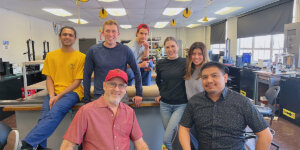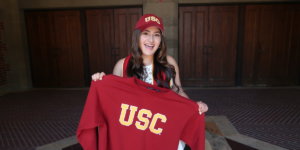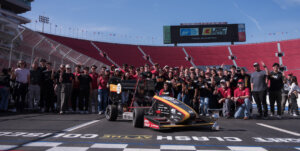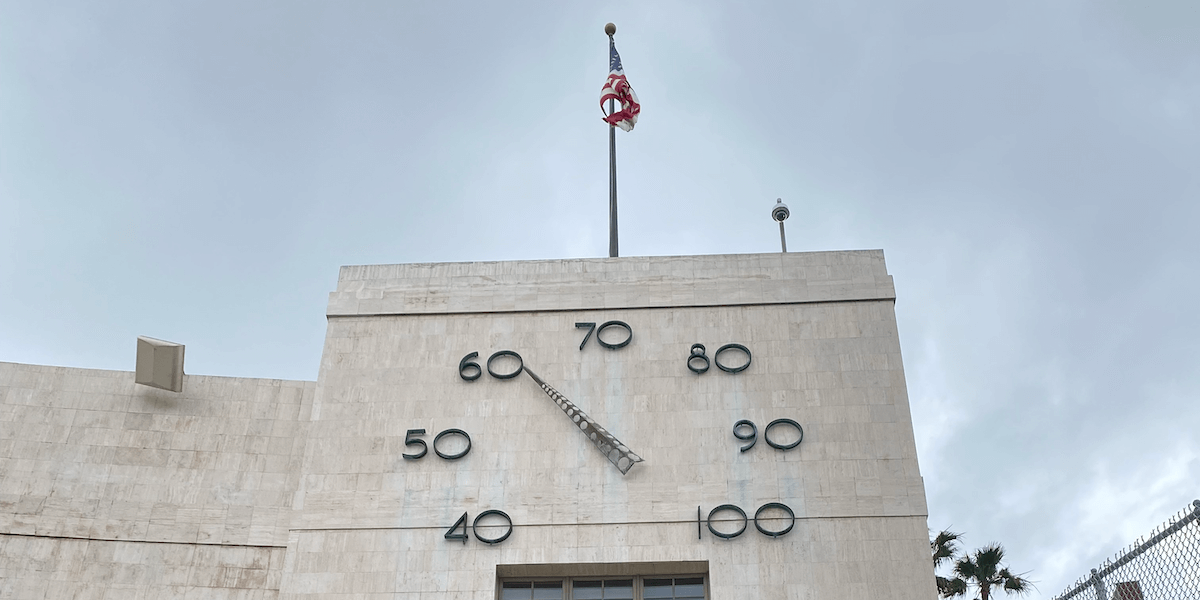
A working thermometer at the Los Angeles Memorial Coliseum. PHOTO/ROD YATES.
For a couple of decades, visitors to the Los Angeles Memorial Coliseum reported consistent 70-degree readings on the stadium thermometer on USC game days.
“Alumni would make fun of the perfect ’70 degree’ reading for many years. It would be in the 90s or frigid, but they’d joke it was the ‘perfect weather’ for football,” said Rod Yates, senior lab technician at the USC Viterbi School of Engineering.
But that reading wasn’t accurate. For what was rumored to be 20 years, Coliseum technicians adjusted the temperature manually on USC game days. Any fluctuations from that reading would fail to register, and by halftime, the reading was likely inaccurate.
In 2013, USC Viterbi School of Engineering seniors decided enough was enough. Enrolled in AME 441 – the senior projects lab for the Department of Aerospace and Mechanical Engineering – three teams of students competed to propose the best design for a new Coliseum thermometer. With a budget of $300, a team including USC Viterbi seniors David Cape, Andrew Ezarik, Charles Palmer and Ryan Magruder created the winning design, which they tested at Biegler Hall. The winning project, voted on by Professors Yann Staelens and Charles Radovich with LA Coliseum interim General Manager John Sandbrook and Project Manager Robert Joyner, was rebuilt into a professional working model and installed in the control room at the Coliseum.
“The student team and professors—including myself—helped with the installation. The most memorable part of the project was when the grounds crew let us use their manlift to balance the needle and record the force we would need to drive the system,” Yates said.
The 2013 model was mainly software-controlled, meaning it took sensor readings and then output controls for a motor that moves the needle to the correct value. The system averages two disparate temperatures — one from a sensor housed within the concrete of the roof and one located in a consistently cool, shady area.
Said Cape at the time, “I thought it’d be really cool to end my senior project with fixing the place I spent most of my Saturdays.”
Model Behavior
Now, in 2022, as post-pandemic crowds are ready to return for USC game days, Yates reported the thermometer was once again broken. The 2013 system, while it worked well, was not built as a long-term solution, Yates said, but as an R&D prototype meant to eventually be replaced with a final product.
The Senior Administrative Director at the Coliseum, Joseph Furin, contacted Staelens to investigate the thermometer and see if he could get it to operate more reliably. “Yann contacted me and I brought Jeffrey Vargas [senior laboratory technician, AME] on board to troubleshoot the existing system,” Yates said.
The Assistant Director of Facilities Operations at the Coliseum, Matthew Busewell, said there was a budget to order a few parts. With the support of AME Chair Paul Ronney, the team decided to create a joint project with the Coliseum, which many in the Trojan Family view as an extension of USC campus.
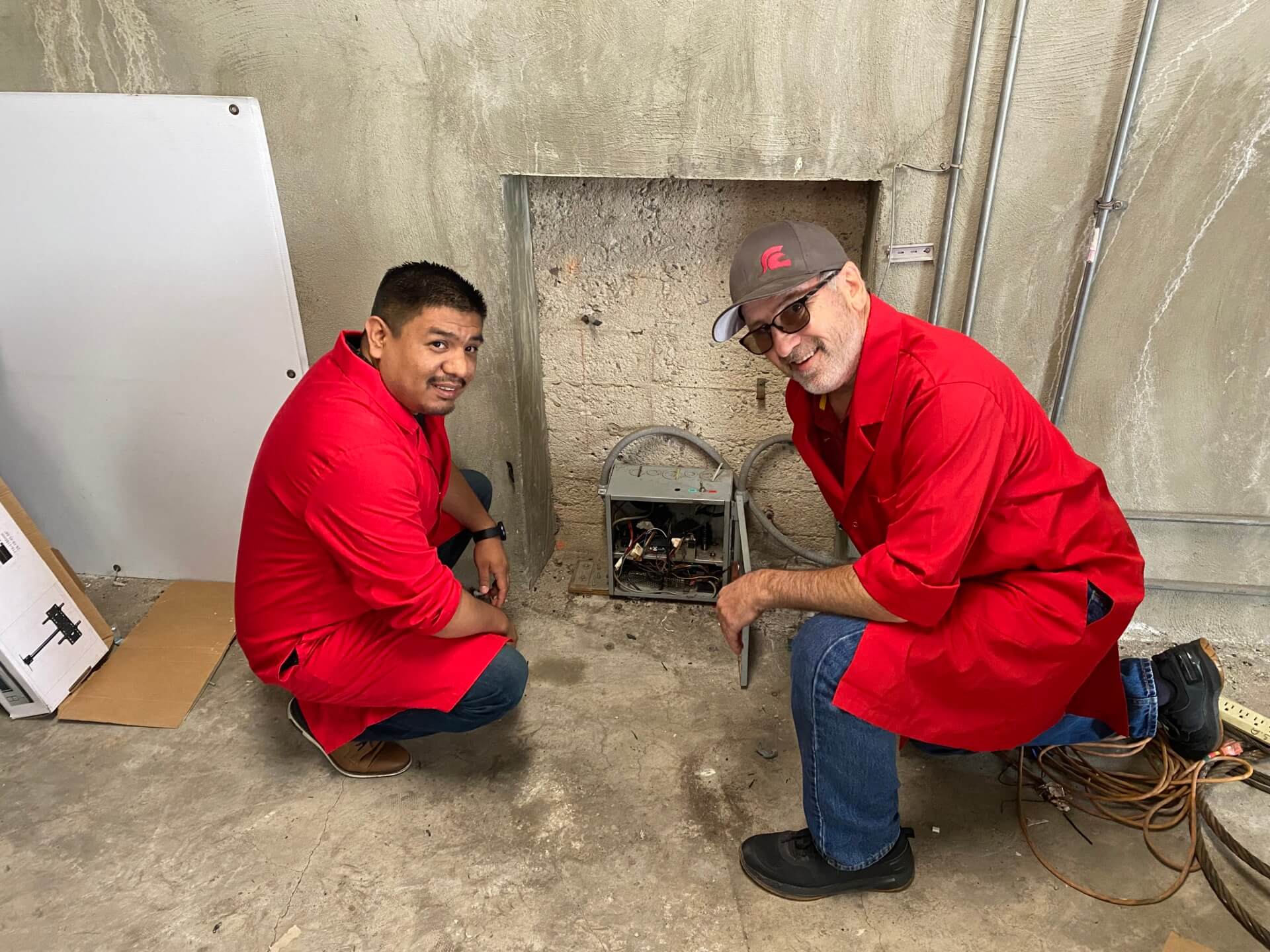
USC Viterbi Lab Managers Rod Yates and Jeffrey Vargas work to update the Coliseum thermometer. PHOTO/JEFFREY VARGAS.
“Jeffrey Vargas, and I were invited to the LA Coliseum to repair the large thermometer on the inside face of the building next to the Olympic torch,” Yates said. “Our first visit was during spring break. We had to evaluate what the students did in 2013 and determine what needed to be repaired. After inspecting the students work, we decided to replace the entire student project. We went back a few more times testing the sensors and taking measurements,” Yates said.
From there, they began the mechanical work. Vargas made a new circuit board and wrote a new code to measure the temperature and drive the new system. Meanwhile Yates redesigned and built a new mechanical gear system to drive the worm gear (a type of gear system that uses friction to precisely control the gear’s motion). That system in turn controls the needle on the face of the building, moving it to reflect the correct temperature. The control system recalibrates and sets the temperature every five minutes to make sure the temperature is consistently and constantly correct.
Said Yates: “After a few decades, the thermometer finally works 24/7. Now during every event at the Coliseum every visitor and fan will know the exact temperature, especially on USC game days.”
Published on June 10th, 2022
Last updated on June 10th, 2022




